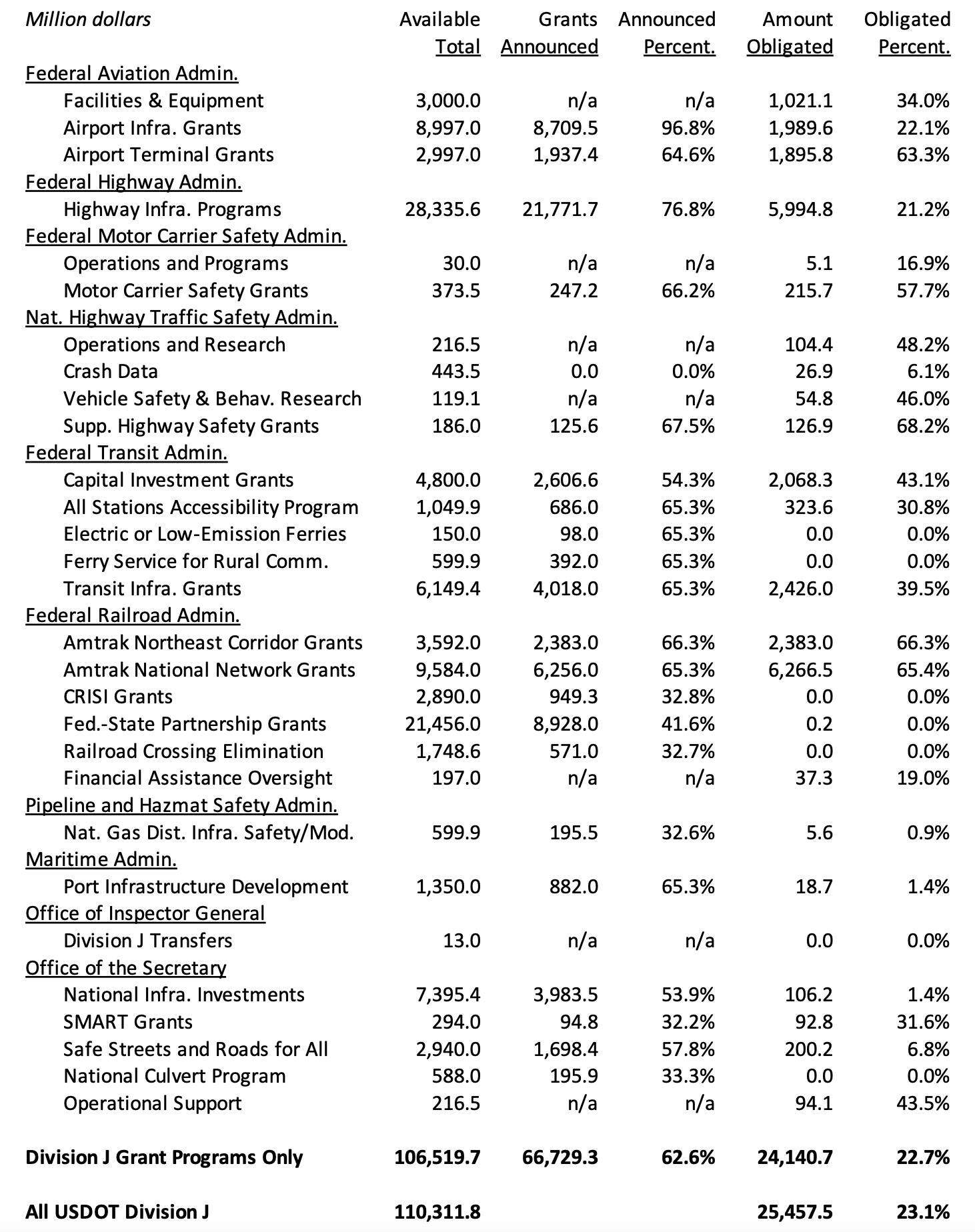Sometime in late December, the U.S. Department of Transportation began a new process of biweekly reporting of how fast the funds provided by the Infrastructure Investment and Jobs Act of 2021 (IIJA) are being processed and spent.
Federal agencies report obligations and outlays of federal dollars to the Treasury Department and the Office of Management and Budget promptly (and largely automatically), but this information was hard to find until the usaspending.gov website was developed. However, usaspending.gov is only updated on a quarterly basis, several weeks after a fiscal quarter ends.
The new USDOT IIJA reporting site says it will be updated biweekly and is therefore several months ahead of any other publicly available budget reporting.
In addition, the new USDOT reporting contains a metric not available anywhere else: the amount of grants announced by the Department for each IIJA account. (These announcements are not legally binding the way that obligations and outlays are, but they do serve as a useful measuring stick as to how far along the Department is the spending process.)
Last month, ETW noted that, according to usaspending.gov, the obligation rate for RAISE grants was falling behind. The new data from DOT confirms that, and points out other problem accounts.
The reporting from DOT combines the ongoing contract authority programs, which are largely formula-based, with the Division J advance supplemental appropriations programs, which are largely competitive grant programs. This is, to an extent, an apples-oranges comparison, so we have separated them. The rates for the Division J advance appropriation accounts, as of December 31, 2023, follow:

While 54 percent of the RAISE/MEGA grant funding has had the recipient projects selected and announced, only 1.4 percent of the money has actually proceeded to the point where a legally binding grant agreement has been signed. And some accounts have zero obligations as of December 31, including the two new IIJA ferry programs at the Federal Transit Administration, the Federal-State Partnership, CRISI, and Railroad Crossing grant programs at the Federal Railroad Administration, and the National Culvert Program in the Secretary’s Office.
(We should not be surprised at the zero obligation rate on culverts. Besides being a new program and getting a slow start on project selection, it is a fact that a leading cause of federal permitting delays is the applicability of the Clean Water Act and the permits required from the Army Corps of Engineers, and that’s usually just for stormwater runoff. The whole point of this culvert program is to change the flow of water so that salmon and other fish can get upstream more easily. It is hard to imagine a type of project that is begging for lengthy Clean Water Act permitting analysis than new culverts.)
On the fast-spending side, grants given directly to Amtrak have always obligated quickly. The FTA Capital Investment Grant advances from the IIJA, so far, have been used to advance the payout schedule for grant agreements that have already been signed, so no permitting is necessary. And the new Airport Terminal Program at the FAA has somehow managed at 64.6 percent grant announcement rate and a 63.3 percent obligation rate, which is phenomenal, quite honestly.
Looking outside Division J, the bulk of the funding provided by the IIJA is not in the form of advance appropriations, but in mandatory funding from the Highway Trust Fund or (in two small instances) other funds. In this instance, the “available total” for fiscal 2024 is only the amount of the part-year obligation limitation provided by the last continuing resolution (plus any contract authority exempt from limitation),
The FHWA, NHTSA, and FMCSA obligation rates are very high, because almost all of this money is governed by “use it or lose it” obligation limitations, and most of it is given by formula to states via a well-oiled machine. The states are accustomed to having to obligate all of their formula money by late September each year and have gotten quite good at it.
FTA obligation rates are lower, because their obligation works differently. Section 160 of the annual DOT Appropriations Act provides that the obligation limitation only applies to new contract authority becoming available for the first time in that budget year. The FHWA, NHTSA and FMCSA obligation limitations apply to new and prior-year carryover contract authority. So FTA obligation authority is not “use it or lose it” by the end of the fiscal year, as is the case with the other three surface bill modes.
Again, as of December 31, 2023:
| Million dollars. |
Available |
Amount |
Obligated |
|
|
Total |
Obligated |
Percent. |
| Federal Highway Admin. |
|
|
|
|
Federal-Aid Highways (HTF) |
120,395.8 |
102,159.1 |
84.9% |
| Federal Motor Carrier Safety Admin. |
|
|
|
|
Operations and Programs (HTF) |
834.1 |
727.9 |
87.3% |
|
Motor Carrier Safety Grants (HTF) |
1,142.6 |
995.1 |
87.1% |
| Nat. Highway Traffic Safety Admin. |
|
|
|
|
Operations and Research (HTF) |
445.2 |
362.1 |
81.3% |
|
Highway Traffic Safety Grants (HTF) |
2,064.5 |
1,898.7 |
92.0% |
| Federal Transit Admin. |
|
|
|
|
Transit Formula Grants (HTF) |
33,936.5 |
13,629.6 |
40.2% |
| Pipeline and Hazmat Safety Admin. |
|
|
|
|
Emergency Preparedness Grants (EPF) |
62.4 |
39.1 |
62.7% |
| Office of the Secretary |
|
|
|
|
Asset Concessions (GF) |
57.7 |
0.0 |
0.0% |
|
TIFIA HTF Transfers (HTF) |
678.9 |
13.3 |
2.0% |
|
|
|
|
|
| Total Available Mandatory BA |
159,617.8 |
119,825.1 |
75.1% |




